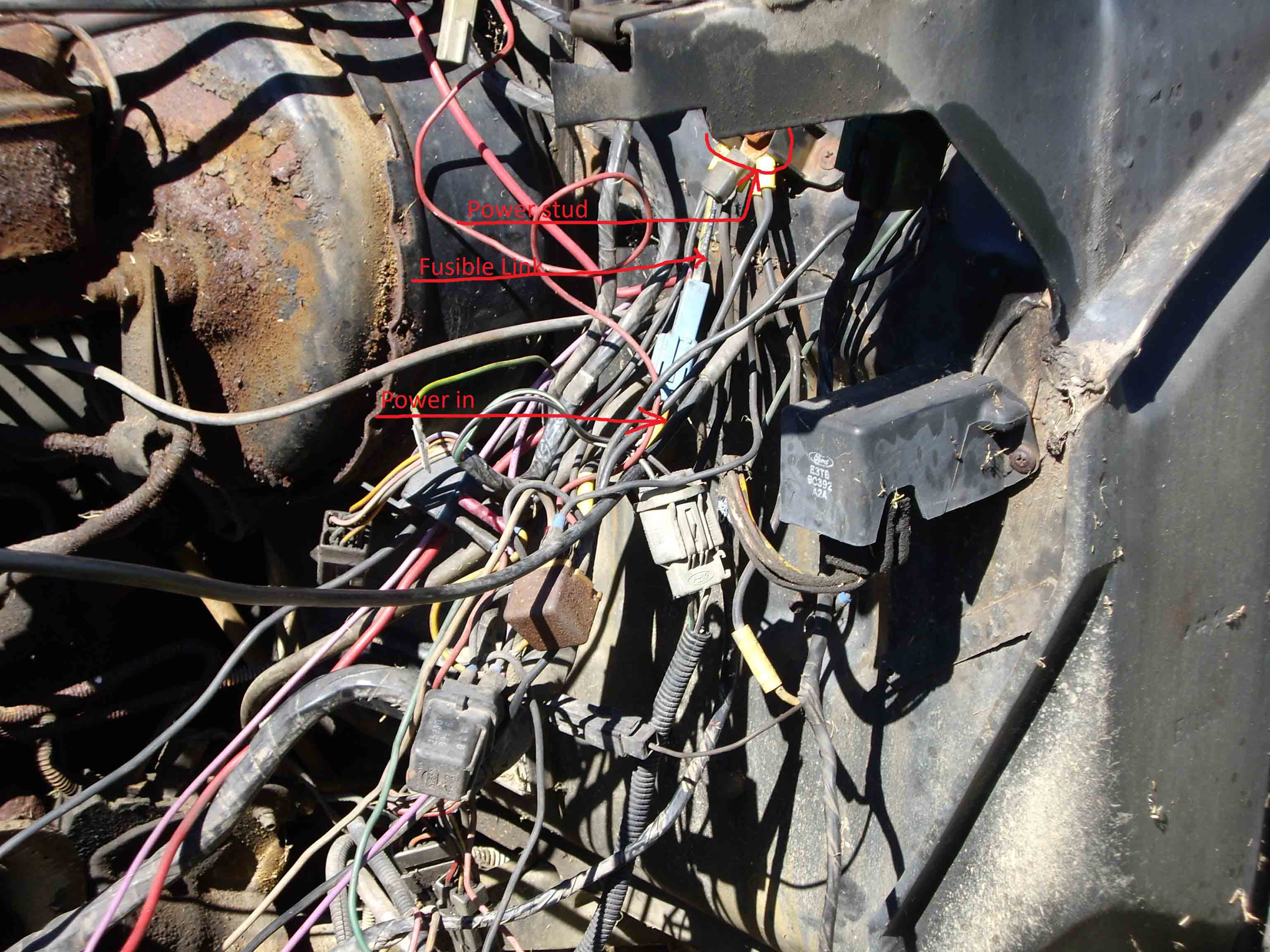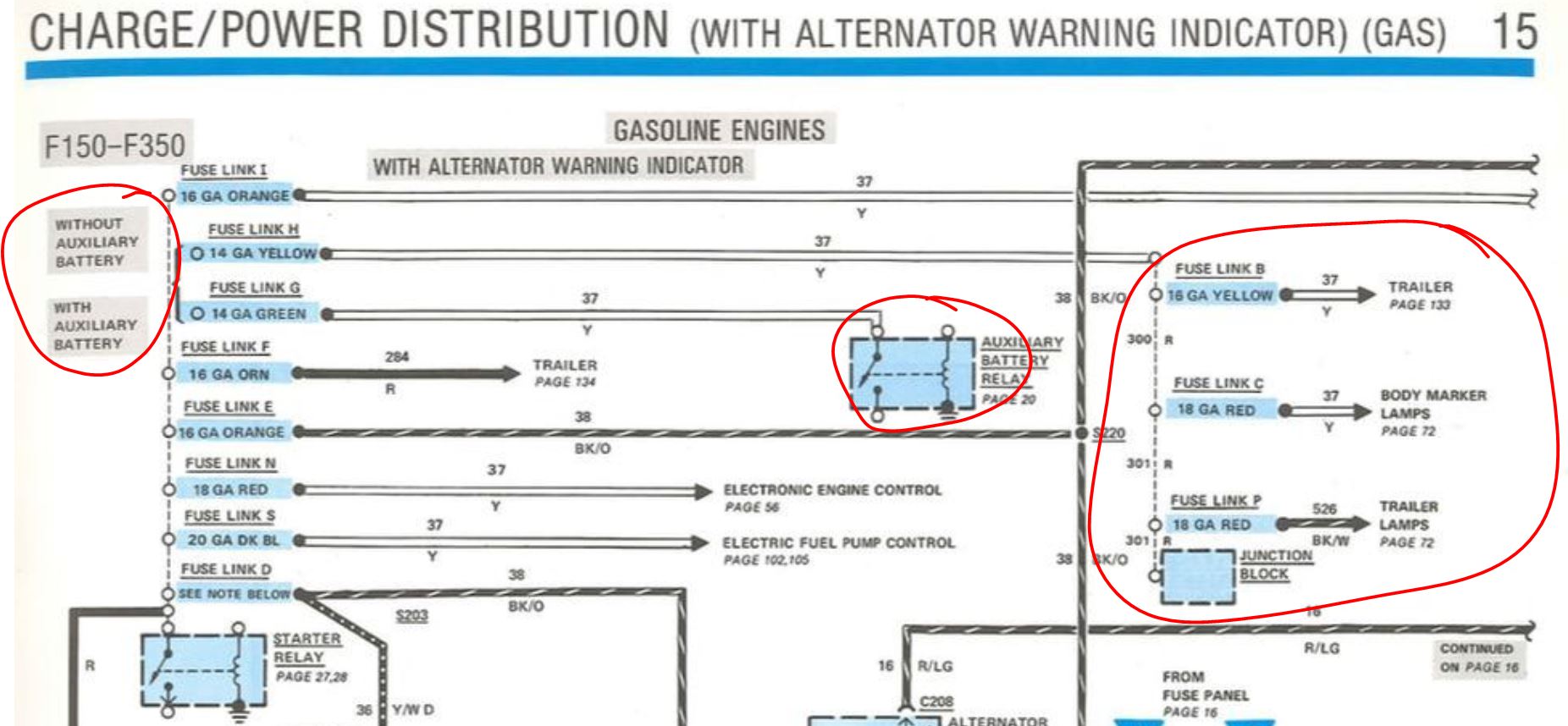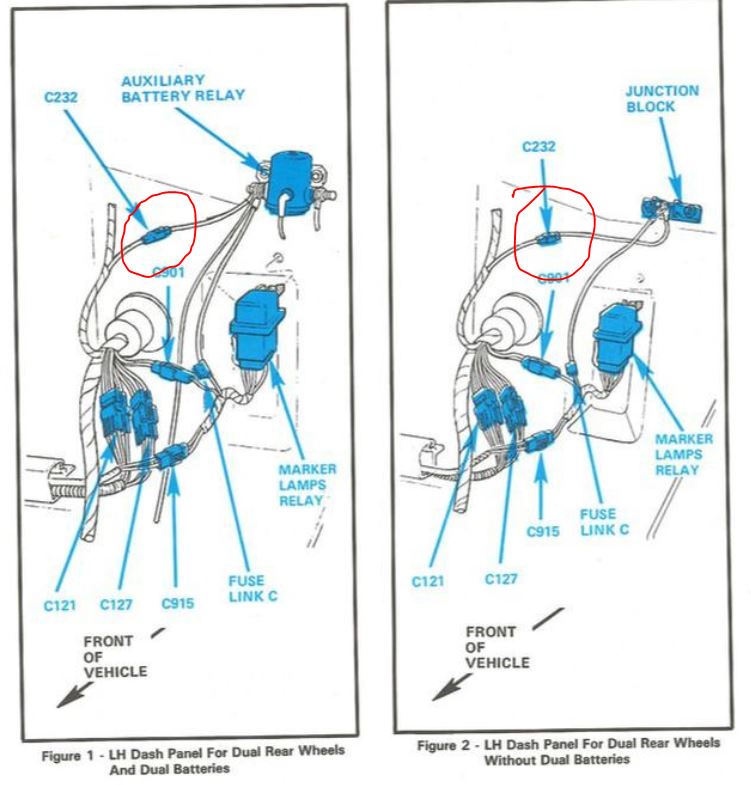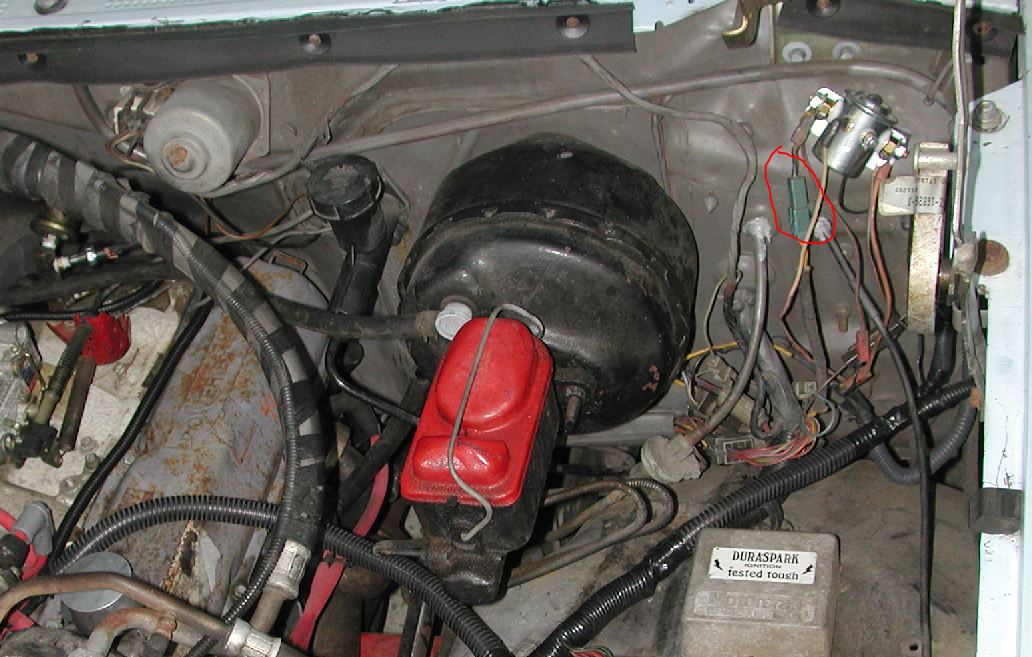Lost and cornfused
|
Thanks. I was just reading about the carb we bought and how it is set up to get a better understanding. Do I understand correctly that manifold is the better of the two to route the vacuum line?
1985 Ford Bronco XLT, 4.9L, NP-435 transmission, NP0208 transfer case, 3.55 limited slip rear end,TTB Dana 44 with 3.54
|
|
Administrator
|
Gary prefers ported.
For good reasons, especially **for someone that has** an automatic. Ford used restricted manifold vacuum with the stock DSII systems **Edit**
Jim,
Lil'Red is a '87 F250 HD, 4.10's, 1356 4x4, Zf-5, 3G, PMGR, Saginaw PS, desmogged with a Holley 80508 and Performer intake. Too much other stuff to mention. |
|
Administrator
|
In reply to this post by Hstrymkrs
I too have worked rotating shifts and can fully understand the "fog" night shift, unless like some I worked with who preferred it is alien to human nature, vampires and zombies, no.
Vacuum advance, easiest way to describe it, it makes up the difference in what the engine can handle under load and what it can handle unloaded or lightly loaded. Performance (racing) engines use either a fixed advance or only a centrifugal (rpm varied) advance system. For years, that was all that was put on cars once automatic advance systems were introduced, other than Ford. Ford used a centrifugal advance with fairly light springs and vacuum brake system. The vacuum brake was a spring loaded piston connected to the intake manifold vacuum and a disc on the movable portion of the centrifugal advance that the brake held back. Higher manifold vacuum would retract the piston and allow the spark to advance more. Chevrolet added an external vacuum diaphragm to the "floating" distributor body which it rotated for more advance. When Ford and Holley started working together in the late 40s, Holley developed the "Load-a-matic all vacuum advance system, no mechanical advance weights or springs. These required either a spark control valve or a check ball so the very weak venturii signal didn't leak, but the stronger ported spark signal was still available. These distributors had a large fairly flat vacuum chamber and two angled springs on the breaker plate. FWIW, (a) Mallory Rev-pol distributors and some of the offshoots of them use the old Ford vacuum brake system (b) GM distributors have one of the easiest mechanical advance systems to re-curve, it's right under the rotor. If DUI uses the Ford style vacuum advance can, it is easily adjusted with a 1/8" Allen wrench. Your Carter or Holley or Motorcraft one barrel should have a manifold and ported vacuum source on it. Ford usually prefers ported spark, but not always, try both after setting the initial timing the way DUI says, then see which way it runs and drives better.
Bill AKA "LOBO" Profile
"Getting old is inevitable, growing up is optional" Darth Vader 1986 F350 460 converted to MAF/SEFI, E4OD 12X3 1/2 rear brakes, traction loc 3:55 gear, 160 amp 3G alternator Wife's 2011 Flex Limited Daily Driver 2009 Flex Limited with factory tow package Project car 1986 Chrysler LeBaron convertible 2.2L Turbo II, modified A413 |
|
Banned User
|
In reply to this post by Hstrymkrs
What do the distributor instructions say to connect it to?
|
|
It is in transit to the house. I will post the answer once it arrives.

1985 Ford Bronco XLT, 4.9L, NP-435 transmission, NP0208 transfer case, 3.55 limited slip rear end,TTB Dana 44 with 3.54
|
|
Banned User
|
Have you tried downloading it from the mfr.'s website?
|
|
Administrator
|
Good idea. Here's a link to the Street/Strip Ford DUI distributor. May not be the right one, but it has several points:
They say you "must" remove the ballast resistor in the wiring harness and run a 12 gauge wire to the "BATT" terminalThey recommend manifold vacuum as "This vacuum advance will keep your plugs cleaner. If your car does not run good at manifold vacuum, then connect it to ported vacuum."They suggest gapping the plugs at .050" to .055" "now that you have enough firepower available"They recommend setting the initial timing to 12 degrees BTDC while idling below 600 RPM and with the vacuum hose pulled off the advance and plugged.
Gary, AKA "Gary fellow": Profile
Dad's: '81 F150 Ranger XLT 4x4: Down for restomod: Full-roller "stroked 351M" w/Trick Flow heads & intake, EEC-V SEFI/E4OD/3.50 gears w/Kevlar clutches
|
|
Administrator
|
Jonathan [FordF834] has a Duraspark distributor [not HEI, though] which was sold and set-up by Performance Distrbutors in TN. It was used in my truck for years and is now providing reliable service for his truck.
Gary, it is the one you worked with when "dialing in" my truck. |
|
Administrator
|
In reply to this post by Gary Lewis
Gary, FWIW, using the power harness for the TFI eliminates the ballast resistor from the equation. The #12 wire though, is what drives you to using a relay to power the DUI system. This was the point I was making several posts back about the HEI being a power hog. Are you (I can't look at the diagram right now) recommending going from the battery terminal of the starter relay? I think I would use the nice battery source on the driver's side, the insulated stud. That would put everything fairly close to the existing ignition system wiring and the new distributor.
If he can find a relay cover like the trailer package and DRW trucks used I'm sure he could stick the relay under there. If not, maybe one of the Bosch relays with a mounting tab so it can be installed right side up (terminals down) as Steve points out they are pretty weatherproof if somewhat protected from the worst conditions. The .050 - .055 gap sounds about right for an HEI system, I don't have tune-up specs for anything that old my information starts at 1982, Chevy that year was .045 gap, but the Oldsmobile 307 was .060 gap. Manifold vacuum was what most GM engines used until the first emission systems in 1968 and I know that ported spark and Chevrolet engines did not play well together, yet Chrysler used ported spark with no issues, but their static timing was as high as 12.5° BTDC on the big blocks, Chevy was on the order of 4-6° BTDC on most engines.
Bill AKA "LOBO" Profile
"Getting old is inevitable, growing up is optional" Darth Vader 1986 F350 460 converted to MAF/SEFI, E4OD 12X3 1/2 rear brakes, traction loc 3:55 gear, 160 amp 3G alternator Wife's 2011 Flex Limited Daily Driver 2009 Flex Limited with factory tow package Project car 1986 Chrysler LeBaron convertible 2.2L Turbo II, modified A413 |
|
Administrator
|
David/1986F150Six - Yes, I remember that distributor. And it really helped Jonathan's truck when he installed it to replace his worn-out one. (Which is an interesting point as we cuss and discuss buying a new vs used distributor.)
Bill/85lebaront2 - I understood what you were saying about the HEI being a power hog. It saturates that coil with lots of current, which is what gives it such a hot spark. (Remember when they first came out and a burned distributor cap or rotor was par for the course?) But I don't know of the "nice battery source on the driver's side, the insulated stud". I'm not familiar with that source, but it would certainly simplify things to have power closer to where the relay may need to be. Can you provide a pic or show it somehow? And I agree about the relay cover. I'd been saving that bit until last, until we get the wiring sorted out. But I'm not sure that a Bosch relay fits in/under that cover very well. So some research is needed to come up with a neat solution since the page I'm thinking about needs to cover all the issues.
Gary, AKA "Gary fellow": Profile
Dad's: '81 F150 Ranger XLT 4x4: Down for restomod: Full-roller "stroked 351M" w/Trick Flow heads & intake, EEC-V SEFI/E4OD/3.50 gears w/Kevlar clutches
|
|
Banned User
|
It's indicated in this diagram by a pointer in the stock wiring:  Here's the rare item itself:  They're available new in a variety of shapes, colors, & forms: https://www.amazon.com/dp/B00784HYI2 https://www.amazon.com/dp/B07CCGCWKD https://www.amazon.com/dp/B07C45948D IDK why anyone would want a red & black pair since there's no reason to insulate the ground side - it can just be a bolt or stud in the body, on the frame, or in the engine (which already exist). For the passenger's side, just use the starter relay, like Ford did. For '92-up (or older trucks with that wiring swapped in  ), there's one under a sliding cover on the PDB on the driver's side. ), there's one under a sliding cover on the PDB on the driver's side.

|
|
In reply to this post by Gary Lewis
Correct, Gary. I have read their FAQs and this is how they recommend setup. If I run off vacuum, then I can wire into the tach wire that is listed on the above diagram that you pointed out. If not, then I will run the vacuum line from the manifold. I am leaning toward the vacuum now.
As I mentioned before, the end goal of this project is not 100% known. My father and I have some differing opinions on where we want to take this Bronco. I am doing the labor, and he is doing the financing. We are both open minded...sort of. Depending on the end goal, just a trail/rock crawler, then the vacuum might not be as big of a deal as it will most always be under load. If it is an all around trail/daily driver type of ride, then the vacuum will be beneficial. It seems almost too easy and straight forward. That is one of the reasons why I brought up the question.
1985 Ford Bronco XLT, 4.9L, NP-435 transmission, NP0208 transfer case, 3.55 limited slip rear end,TTB Dana 44 with 3.54
|
|
In reply to this post by Steve83
I will look, but I don't think I have this accessory post on the Bronco. Now that I know what it looks like, I might better be able to find it.
1985 Ford Bronco XLT, 4.9L, NP-435 transmission, NP0208 transfer case, 3.55 limited slip rear end,TTB Dana 44 with 3.54
|
|
Administrator
|
Figure 4 page 19 of the 1986 EVTM shows it's location, it is called the Left Side Junction Block.

Bill AKA "LOBO" Profile
"Getting old is inevitable, growing up is optional" Darth Vader 1986 F350 460 converted to MAF/SEFI, E4OD 12X3 1/2 rear brakes, traction loc 3:55 gear, 160 amp 3G alternator Wife's 2011 Flex Limited Daily Driver 2009 Flex Limited with factory tow package Project car 1986 Chrysler LeBaron convertible 2.2L Turbo II, modified A413 |
|
Administrator
|
In reply to this post by Hstrymkrs
William - I may have misunderstood, but the vacuum and tach issues are separate. You have a dark green/yellow wire, which you can see in the first of the two diagrams I posted, that goes to the tach. You'll connect that wire to the Tach terminal on the DUI dizzy. And, the dizzy will have a vacuum port on the front of it that you'll take to some source of either manifold or ported vacuum. But, I probably misunderstood.
However, I'm with you on that power stud - I doubt yours has it. I have two Bullnose trucks, and have owned bunches of them. And of all those only one has the stud - Big Blue, which also has the trailering option and auxiliary battery. I believe that it takes one or the other of those, or the camper option, to get that stud. So, as Steve said, the fall-back is to go to the always-hot side of the solenoid - and then make sure you fuse it! DUI says it should be a #12 wire, so the question becomes how big of a fuse to use. I'd say a 20 amp fuse would be fine, although #12 is good for more than that. (Steve - I know that there are many different tables on that, but I just turned in a copy of Ford's Body Building book to scan and as I was looking to see which pages I wanted scanned I found a table which said that #14 is good for 25 amps. I wish I had the book now, but that must mean Ford thought #12 is good for 35 or 40 amps!)
Gary, AKA "Gary fellow": Profile
Dad's: '81 F150 Ranger XLT 4x4: Down for restomod: Full-roller "stroked 351M" w/Trick Flow heads & intake, EEC-V SEFI/E4OD/3.50 gears w/Kevlar clutches
|
|
Administrator
|
12Ga @ 20A is NEC for solid copper wire in a wall.
It is derated quite a bit. There are tables online showing ratings for stranded copper in a wiring harness. Yes, it's probably 30A or more.
Jim,
Lil'Red is a '87 F250 HD, 4.10's, 1356 4x4, Zf-5, 3G, PMGR, Saginaw PS, desmogged with a Holley 80508 and Performer intake. Too much other stuff to mention. |
|
Administrator
|
In reply to this post by Gary Lewis
Gary, William, even if the junction block isn't there, the yellow circuit 37 wire should be there with an open connection available. I think it would be a 1/4" terminal but can't remember or determine whether it would be male or female. If it will help, the Bosch relays in my Chrysler PDC have a 40 amp fuse for the cooling fans and I believe the internal feeds are #12 in it.
Bill AKA "LOBO" Profile
"Getting old is inevitable, growing up is optional" Darth Vader 1986 F350 460 converted to MAF/SEFI, E4OD 12X3 1/2 rear brakes, traction loc 3:55 gear, 160 amp 3G alternator Wife's 2011 Flex Limited Daily Driver 2009 Flex Limited with factory tow package Project car 1986 Chrysler LeBaron convertible 2.2L Turbo II, modified A413 |
|
Administrator
|
Jim - I agree that it is derated quite a bit in all the tables, but Ford's rating for #14 boggled my mind. The rating for #14 of 15 amps has always been my reference point, but to see it at 25 was strange. No wonder the headlights dim. I'll bet they've got #18 rated at 10+ amps.
 Next week some time I'm to get that book back scanned and I'll be creating a page for it in Specifications. Then we shall know. Bill - I believe you are right that Circuit 37 is there, and that it has a female 1/4" terminal. So that would be a good place to get the power for this. Notice that the fuselink is #14, assuming the truck has an ammeter, so it is effectively fused at something more than 25 amps. Do we think it still needs its own fuse coming off the end of #37? 
Gary, AKA "Gary fellow": Profile
Dad's: '81 F150 Ranger XLT 4x4: Down for restomod: Full-roller "stroked 351M" w/Trick Flow heads & intake, EEC-V SEFI/E4OD/3.50 gears w/Kevlar clutches
|
|
In reply to this post by Gary Lewis
I agree that the hot side of the solenoid would be the better option and I would fuse the #12 ga wire.
1985 Ford Bronco XLT, 4.9L, NP-435 transmission, NP0208 transfer case, 3.55 limited slip rear end,TTB Dana 44 with 3.54
|
|
Administrator
|
William - Could you do me, and I think you, a favor? Please confirm that you have C232, as shown below. This would be, as Bill and Steve pointed out, the easiest place for you to get power as it is on the driver's side of the truck so you don't have to run a wire all the way across.
Here's the illustration from the EVTM showing the area just to the right of the brake master cylinder, with C232 circled. It will be a big yellow wire with a grayish green connector that probably isn't connected to anything.  And here's Big Blue's C232. You can see that it is connected to the aux battery solenoid, exactly like the illustration above shows. But since you probably don't have an aux battery or the trailer wiring then that wire isn't used. 
Gary, AKA "Gary fellow": Profile
Dad's: '81 F150 Ranger XLT 4x4: Down for restomod: Full-roller "stroked 351M" w/Trick Flow heads & intake, EEC-V SEFI/E4OD/3.50 gears w/Kevlar clutches
|
| Edit this page |

